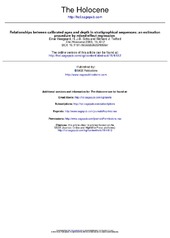Relationships between calibrated ages and depth in stratigraphical sequences: an estimation procedure by mixed-effect regression
Peer reviewed, Journal article
Permanent lenke
https://hdl.handle.net/1956/2489Utgivelsesdato
2005Metadata
Vis full innførselSamlinger
Originalversjon
https://doi.org/10.1191/0959683605hl836rrSammendrag
We present a procedure for estimating age-depth relationships in stratigraphical sequences by means of a generalized mixed-effect regression using an ancillary function for the partitioning of the fixed effect and the random effect corresponding to the degree of representativity of the individual calibrated dates for a particular section of the sedimentary sequence. The procedure uses mid-point estimates of the calibrated ages in combination with the central distributional range as the basis for estimating the fixed relationship between age and depth. Further, it combines the variability of the calibrated age at individual layers (within-object variance) with estimation of the variability of the calibrated age distribution as a whole between the layers standardized by the fixed effect (between-object variance). These components of random variability can be considered independent, and hence the uncertainty of the estimated fixed relationship between age and depth can be estimated by combining the two random variables. The procedure follows the logic of mixed-effects models, but with prior information about the expected variance within each dated object.
